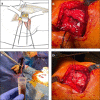No difference in bacterial contamination of hip capsule sutures and control sutures in hip arthroplasty surgery
- PMID: 37710282
- PMCID: PMC10503031
- DOI: 10.1186/s13756-023-01305-0
No difference in bacterial contamination of hip capsule sutures and control sutures in hip arthroplasty surgery
Abstract
Background: Perioperative preventive measures are important to further reduce the rate of periprosthetic joint infections (PJI) in patients undergoing total hip arthroplasty (THA). During THA surgery, joint capsule sutures are commonly placed to optimize exposure and reinsertion of the capsule. Bacterial contamination of these sutures during the procedure poses a potential risk for postoperative infection. In this exploratory study, we assessed the contamination rate of capsule sutures compared to the contamination of the remains of exchanged control sutures at the time of closure.
Methods: In 100 consecutive patients undergoing primary THA capsule sutures were exchanged by sterile sutures at the time of capsule closure. Both the original sutures and the remainder of the newly placed (control) sutures were retrieved, collected and cultured for ten days. Types of bacterial growth and contamination rates of both sutures were assessed.
Results: Sutures from 98 patients were successfully collected and analyzed. Bacterial growth was observed in 7/98 (7.1%) of the capsule sutures versus 6/98 (6.1%) of the control sutures, with a difference of 1% [CI -6-8]. There was no clear pattern in differences in subtypes of bacteria between groups.
Conclusions: This study showed that around 7% of capsule sutures used in primary THA were contaminated with bacteria and as such exchange by new sutures at the time of capsule closure could be an appealing PJI preventive measure. However, since similar contamination rates were encountered with mainly non-virulent bacteria for both suture groups, the PJI preventive effect of this measure appears to be minimal.
Keywords: Bacterial contamination; Capsule Sutures; Total hip arthroplasty.
© 2023. BioMed Central Ltd., part of Springer Nature.
Conflict of interest statement
The authors declare no competing interests.
Figures

Similar articles
-
The Impact of Running, Monofilament Barbed Suture for Subcutaneous Tissue Closure on Infection Rates in Total Hip Arthroplasty: A Retrospective Cohort Analysis.J Arthroplasty. 2019 Sep;34(9):2006-2010. doi: 10.1016/j.arth.2019.05.001. Epub 2019 May 9. J Arthroplasty. 2019. PMID: 31182411
-
Short-term Complications After Revision Hip Arthroplasty for Prosthetic Joint Infection Are Increased Relative to Noninfectious Revisions.J Arthroplasty. 2018 Sep;33(9):2997-3002. doi: 10.1016/j.arth.2018.05.001. Epub 2018 May 9. J Arthroplasty. 2018. PMID: 29853307
-
Barbed sutures in total hip and knee arthroplasty: what is the evidence? A meta-analysis.Int Orthop. 2016 Feb;40(2):225-31. doi: 10.1007/s00264-015-3049-3. Epub 2015 Nov 17. Int Orthop. 2016. PMID: 26572888
-
Transverse posterior wall acetabular fracture pattern is associated with increased risk of periprosthetic joint infection after conversion total hip arthroplasty.Injury. 2023 Aug;54(8):110883. doi: 10.1016/j.injury.2023.110883. Epub 2023 Jun 8. Injury. 2023. PMID: 37394330
-
Can Topical Vancomycin Prevent Periprosthetic Joint Infection in Hip and Knee Arthroplasty? A Systematic Review.Clin Orthop Relat Res. 2021 Aug 1;479(8):1655-1664. doi: 10.1097/CORR.0000000000001777. Clin Orthop Relat Res. 2021. PMID: 33929342 Free PMC article.
References
Publication types
MeSH terms
LinkOut - more resources
Full Text Sources
Medical

